Light-Reflection & Refraction
Que 1. Which one of the two-glass and water is optically denser and why?
Ans. Glass is denser than water because speed of light in glass is less than that of water.
Que 2. Why does white light split up into different colours while passing through a glass prism?
Ans. Light of different wavelengths (different colours) present in white light have different speed. Hence, these deviate through different angles inside the prism and get separated.
Que 3. Can a convergent lens in one medium become divergent in another medium?
Ans. Yes, a convergent lens in one medium becomes divergent in another medium when the refractive index of the medium is greater than the refractive index of the material of the lens.
Que 4. A man is going away from the plane mirror with a velocity of 3 m/s. With what velocity is he going away from his own image in the mirror?
Ans. We know that the image formed by a plane mirror is as much behind the mirror as object is in front. So, the speed of image will be same as object but in opposite direction. Thus, net velocity between man and his image will be 3 - (-3) 6 m/s.
Que 5. Under what condition a convex lens when placed in a medium behaves as an ordinary glass plate?
Ans. When the refractive index of a medium relative to lens is one, a convex lens will behave as an ordinary glass plate.
Que 6. Why does a concave mirror has a real principal focus?
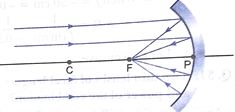
Ans. In a concave mirror, all the incident rays parallel to principal axis actually pass through the focus F after getting reflected from the concave mirror. Thus, concave mirror has a real principal focus.
Que 7. A concave mirror and convex lens are immersed in water. What change, if any, do you expect in the focal length of the two?
Ans. Focal length of the concave mirror does not change because it is about half its radius of curvature and has nothing to do with the external medium. On the other hand, the focal length of the convex lens will increase because the refractive index of glass with respect to water is less than refractive index of glass with respect to air.
Que 8. Which is a better reflector-a plane mirror or a right-angled prism?
Ans. A right-angled prism is a better reflector, because light incident on its hypotenuse is totally reflected without absorption of light. On the other hand, in case of a plane mirror, there is a possibility of partial absorption of light.
Que 9. A man is holding a lighted cand le in front of a thick glass mirror and on viewing it obliquely he noticed a number of images of the cand le why?
Ans. The front surface of a thick glass mirror is both reflecting and refracting. The back surface is silvered and acts as a mirror. Images arise due reflection of incident light by the front surface then by back surface, following by multiple reflection of light within the glass by the front and back surfaces.
Que 10. A concave mirror of length f produces an image n times the size of the object. What would be the object distance for which the image is real?
Ans. We have given 
In case of concave mirror, if the image is real then it must be inverted.

From mirror formula, we get

Que 11. In the following figures, one lens is placed inside each box. State the nature of the lens. Complete the ray diagrams.

Ans.

In figure (a), the incident rays are diverged after refraction, so the lens is concave.
In figure (b), the incident rays are converged after refraction, so the lens is convex.
Que 12. A convex lens forms a blurred image of an object on a screen.
Suggest a suitable way to get a sharp image on a screen without disturbing the object, lens or the screen.
Ans. By placing another lens of suitable nature and focal between the object and the screen.
Que 13. Why does a ray of light parallel to the principle axis
(i) bend towards the principle axis in the case of a concave mirror and
(ii) goes away from the principle axis in the case of a convex mirror as shown here?
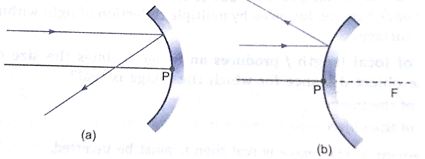
Ans. A ray of light incident on any spherical mirror follows laws of reflection.
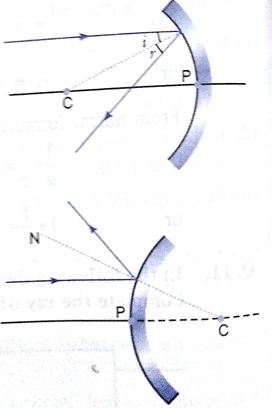
(i) In case of a concave mirror, the line joining the point of incidence ray and the centre of curvature forms the normal as shown. The reflected ray goes on the other side of the normal following laws of reflection.
(ii) In the case of convex mirror, the normal at the point of incidence is as shown. The reflected ray goes on the other side of the normal. Following laws of reflection as shown. Hence, it goes away from the principal axis.
Que 14. The ray diagrams given below show the paths of a ray of light travelling from a medium M into different media 1, 2 and 3.

(a) In which of three media 1, 2 or 3 does light travel: (i) faster, (ii) slower than in medium M?
(b) Arrange the media 1, 2 and 3 in descending order of (i) speed of light through them,
(ii) their refractive index.
Ans. (a) (i) faster – in medium 2 and 3
(ii) slower – in medium 1
(b) 
(ii) 
Que 15. If x, y and x denote the object distance, image distance and the radius of curvature respectively of a spherical mirror, which one of the following is the correct relation between them?

Ans. For a spherical mirror,
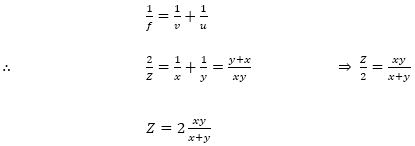
Hence, (a) is the correct answer.
Que 16. You are given lenses with powers + 10 D, + 5 D, - 5 D, - 20 D, and – 10 D. Taking a pair of lenses at a time, which two lenses will you select to have a combination of total focal length when the two lenses are kept in contact in each case.
(i) 20 cm (ii) – 10 cm (iii) – 20 cm (iv) 
Ans. 
(i) When lenses of 10 D and – 5 D are taken, total power
P = P1 + P2
= 10 D – 5 D = 5 D

(ii) When lenses of 10 D and – 20 D are taken
P = 10 D – 20 D
= - 10 D

(iii) When lenses of + 5 D and – 10 D
P = - 5 D

F = - 20 cm
(iv) When lenses of 10 D and 5 D are taken
P = 15 D

Que 17. A student recorded the following data for the values of the object distance and corresponding image distance while performing an experiment on real image formation by a convex lens of power + 4 D. Two of these observations are incorrect.
Without making any calculations, identify these observations and give reason for your choice.
|
Observation |
A |
B |
C |
D |
E |
|
Object Distance u (cm) |
30 |
40 |
50 |
60 |
70 |
|
Image Distance v (cm) |
20 |
60 |
50 |
70 |
30 |
Ans. Reading A and D are incorrect.
Reason: The focal length of the lens is 25 cm.
(i) In reading A, the object is kept at 30 cm from the lens, i.e., between F and 2F. The image should be formed beyond 2F (50 cm). However, it is shown to be at 20 cm, which is incorrect.
(ii) In reading D, the object is kept beyond 2F, i.e., 50 cm. The image should be formed between F and 2F. However, it is also shown to be formed at 60 cm, i.e., beyond 2F. Hence it is incorrect.
Que 18. The given ray diagram shows a ray of light PQ striking a mirror AB. The mirror AB and CD are at an angle of 120 with each other. The ray PQ strikes the surface of the mirror Ab at point Q.
with each other. The ray PQ strikes the surface of the mirror Ab at point Q.
(i) Draw the complete path of reflection of the ray at mirrors AB and CD.
(ii) Calculate the sum of angles which the reflected rays make with the surfaces of mirrors AB and C.
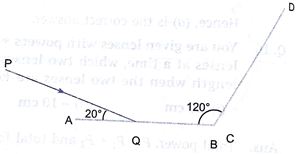
Ans. (i)
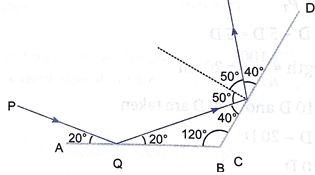
(ii) The sum of the angles, made by reflected rays with mirrors AB and Cd is
20 + 40
+ 40 = 60
= 60
Que 19. Compare and contrast between the image formation by a concave and convex mirror. Write the similarities in the common space and the dissimilarities in the left side or the right side.
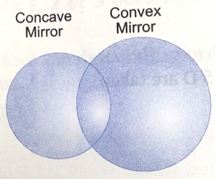
Ans. Similarity:
(i) Both can form virtual images.
(ii) Both can form erect images.
Dissimilarity:
(i) Concave mirror can form a real as well as virtual image whereas convex mirror can form only virtual image.
(ii) Concave mirror can form magnified as well as diminished image whereas convex mirror forms only diminished image.
(iii) Concave mirror can form erect as well as inverted image whereas convex mirror always forms an erect image.
Que 20. Playing with an old lens one morning, Ravi discovers that if he holds the lens 10 cm away from a wall opposite to a window, he can see a sharp but upside-down picture of outside world on the wall. That evening, he covers a lighted lamp with a piece of opaque paper on which he has pierced, a small hole 1 mm in diameter. By placing the lens between the illuminated card and the wall, he manages to produce a sharp image of diameter 5 mm on the wall.
Answer the following questions based on the above information:
(i) What is the power of the lens?
(i) In the evening experiment, how far away from the opaque paper did he place the lens?
(iii) How far apart were the card and the wall?
Ans. (i) Since the rays from far away object get focussed at the principal focus, distance between lens and wall is equal to focal length 10 cm.
 Power of the lens = + 10 D.
Power of the lens = + 10 D.
(ii) In the evening experiment,
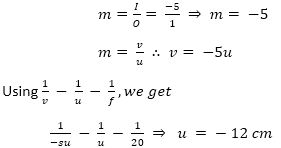
(iii) v = 60;
Thus u + v = 60 + 12 = 72 cm
Que 21 If the image formed by a lens for all positions of the object placed in front of it is always virtual, erect and diminished, state the type of the lens. Draw a ray diagram in support of your answer. If the numerical value of focal length of such a lens is 20 cm, find its power in new Cartesian sign conventions.
Ans. It is diverging lens or concave lens.
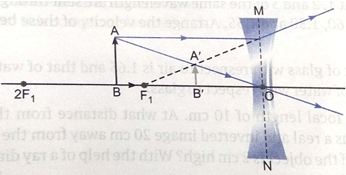
Focal length = - 20 cm (lens is concave, hence f is – ve)


